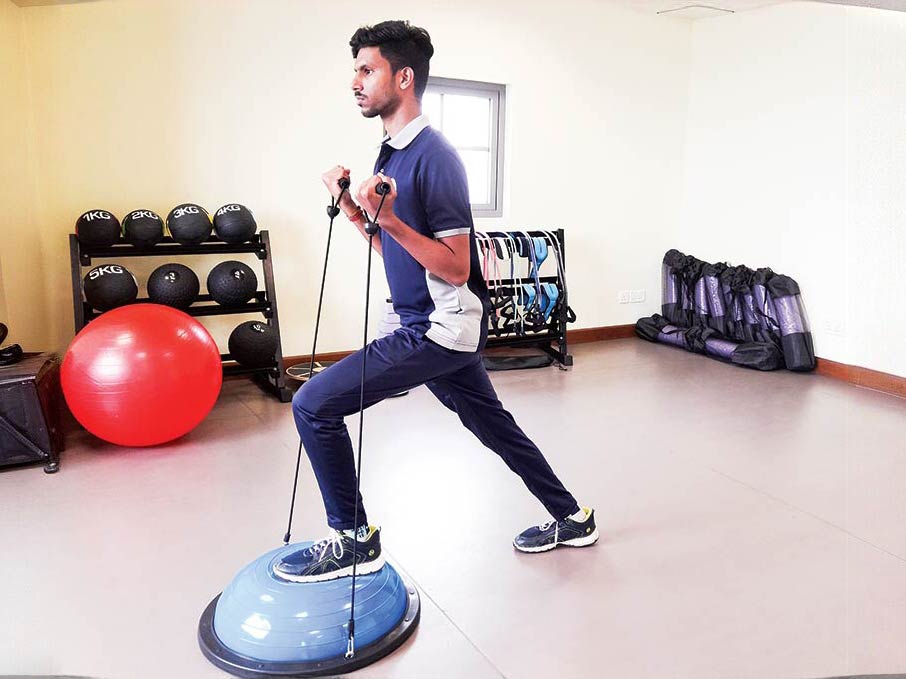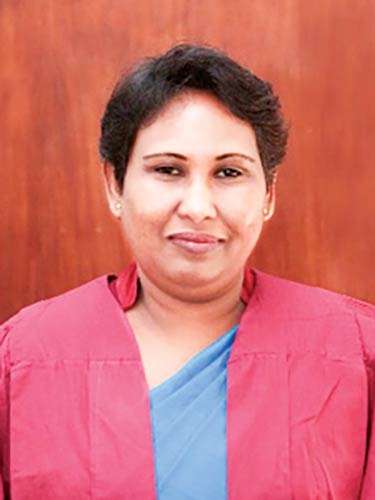Life style
Physiotherapy for optimal performance in sports

BY RANDIMA ATTYGALLE
Sports physiotherapy is a specialized field that focuses on the prevention, treatment, and rehabilitation of injuries related to sports and physical activity. Unlike general physiotherapy, which encompasses a broad range of medical conditions, sports physiotherapy addresses the unique needs of athletes and active individuals.
With their specialized knowledge, sports physiotherapists, manage sports injuries, enhance athletic performance, implement injury prevention strategies, and contribute to the overall health and well-being of players and athletes. The role of the sports physiotherapist in international sports competitions is significant today.
In an interview with Sunday Island, Dr. Subashini Jayawardana, senior physiotherapist, educator, and Head of the Department of Allied Health Sciences at the Faculty of Medicine, University of Colombo, sheds light on this specialized branch of physiotherapy which calls for better recognition here at home.
Following are the excerpts:
Q: Could you brief on the scope of physiotherapy in sports?
A: A sports physiotherapist plays a crucial role as part of a multidisciplinary team, working alongside coaches, trainers, massage therapists, sports physicians, counselors, and nutritionists. The primary responsibility of the sports physiotherapist is to help athletes and sports professionals perform at their optimal levels by preventing injuries and managing them through acute interventions and rehabilitation.
However, the role of sports physiotherapists extends far beyond injury treatment. They also assist uninjured athletes in maintaining musculoskeletal fitness and facilitate post-competition recovery, contributing significantly to the overall enhancement of athletic performance.
Sports physiotherapists rely on evidence-based practices to ensure the highest standards of clinical care. The International Federation of Sports Physical Therapy (IFSPT), a global body representing national sports physiotherapy organizations, has established competencies and protocols aimed at elevating the practice of sports physiotherapy worldwide. These guidelines not only provide a framework for the professional conduct of sports physiotherapists but also promote safe participation of athletes and foster the ongoing development of professionals within the field. By adhering to these standards, the IFSPT aims to improve the quality of sports physiotherapy and ensure the continued advancement of athlete care globally.
Q: What are the short-term and long-term objectives of physiotherapy?
A: The short-term goals of sports physiotherapy focus on effectively managing acute symptoms, such as pain and swelling, following a sports injury. Immediate physical intervention offers numerous benefits, including the prevention of further damage or recurrence of the injury, as well as promoting faster recovery.
Long-term objectives, on the other hand, are centered on ensuring the athlete’s safe return to sport, rebuilding confidence, and achieving enhanced performance levels.
Q: What is the preventive aspect of sports physiotherapy?
A: Physiotherapy plays a critical role in the prevention of sports injuries by employing a comprehensive approach that combines injury risk assessment, biomechanical evaluation, personalized exercise programmes and education on proper movement techniques.
Injury risk assessments allow physiotherapists to identify potential weaknesses and imbalances that may predispose athletes to injury. Meanwhile, biomechanical evaluations analyze sports-specific movement patterns and techniques, helping to ensure that the bones, muscles, and joints function optimally and healthily.
Based on these assessments, physiotherapists develop tailored exercise programmes that address the unique needs of each athlete. These programmes incorporate sport-specific considerations, including warm-up routines, stretching, and strengthening exercises. Additionally, physiotherapists provide athletes with guidance on proper techniques and practices to minimize the risk of musculoskeletal injuries, ensuring safer and more effective performance.
Q: What is the injury-related role played by physiotherapy?
A: When an athlete sustains an injury, physiotherapists intervene across three key stages: the acute phase, the sub-acute phase, and the rehabilitation phase.
During the acute phase, physiotherapists provide immediate on-site support at the time of injury. The sub-acute phase follows, typically lasting from several days to a few weeks after the injury. The rehabilitation process is a critical phase where careful management is essential to ensure a smooth, injury-free return to sport. The physiotherapist’s focus during this phase is on restoring movement control, regaining joint range of motion, and rebuilding muscle strength.
The rehabilitation phase is vital for minimizing the risk of re-injury when the athlete returns to sport. Physiotherapists conduct physical examinations and tailor interventions to meet the specific needs of the athlete. For athletes undergoing surgical interventions, such as ligament reconstruction, physiotherapists follow evidence-based treatment protocols to ensure optimal recovery and successful outcomes post-surgery.
Q: What are the short-term and long-term repercussions of unaddressed sports-related injuries?
A: Secondary trauma is the immediate repercussion. When a player or an athlete is injured his/her common psyche is that regardless of the injury he/she can continue to play or compete. The mind-set is such, we often see them being reluctant to get out of the field. For example, if a badminton player suffers a partial meniscus tear in the knee and continues to play without seeking professional physiotherapy or medical advice, there is a high risk of causing further damage to the meniscus, potentially requiring surgical intervention. This could result in the athlete being sidelined for an extended period, significantly affecting their career.
Neglecting timely and appropriate medical treatment and physiotherapy can increase the risk of aggravating the condition, leading to frequent recurrences and a decline in performance. In many cases, this can ultimately force athletes to abandon their sports careers prematurely.
Furthermore, damage to soft tissues in weight-bearing joints, such as the knee, can lead to long-term complications, including degenerative arthritis in later years. Without proper rehabilitation in the early stages, athletes may eventually require joint replacement surgeries, further diminishing their quality of life and mobility as they age.
Q: What are the advancements found in sports physiotherapy in terms of diagnostics and treatment modalities?
1. Advancements in Diagnostics
High-Resolution Ultrasound: The resolution of ultrasound imaging has greatly improved, enabling physiotherapists to visualize soft tissue injuries, tendon damage, muscle strains, and joint abnormalities in real-time. This technology aids in monitoring tissue healing and guiding targeted therapeutic interventions.
Advanced Motion Capture Systems: Techniques like 3D kinematic analysis are now used to assess an athlete’s movement patterns, helping to identify abnormal motions or compensations that could lead to injury. Early intervention can thus be made to prevent further damage or enhance performance.
Wearable Devices: Devices such as accelerometers, gyroscopes, and pressure sensors provide real-time data on movement mechanics, load, and forces. This continuous monitoring allows physiotherapists to track athletes’ progress and adjust treatment plans accordingly.
2. Advancements in Treatment Modalities
Instrument-Assisted Soft Tissue Mobilization (IASTM): utilize specialized instruments to break down scar tissue and facial adhesions, improving mobility and alleviating pain.
Active Release Technique (ART): ART targets soft tissue restrictions caused by muscles, tendons, ligaments, and nerves. Commonly used for treating overuse injuries, this hands-on technique aids in restoring optimal tissue function.
Dry needling: involves inserting fine needles into trigger points to relieve muscle tension and improve blood flow. It is particularly effective for treating myofascial pain and chronic muscle tightness, common among athletes suffering from muscle strains.
Postural and Core Stability Training: These exercises focus on enhancing posture, balance, and core strength, preventing injury and improving performance.
Sport-Specific Rehabilitation: Treatment protocols are increasingly customized to address the unique movement patterns, agility drills, and strength requirements of the athlete’s sport.
Virtual Reality (VR): VR technology is being used to simulate real-life sports scenarios, aiding in functional movement recovery. This immersive environment enhances both cognitive and motor rehabilitation for athletes.
Telehealth & Remote Monitoring: Telehealth allows physiotherapists to conduct virtual consultations and monitor recovery remotely. Wearable devices integrated with apps enable physiotherapists to track progress and make adjustments to treatment plans in real-time.
Active Recovery & Compression Therapy
Devices like pneumatic compression sleeves and cryo-compression systems have been developed to accelerate recovery. These devices improve circulation, reduce swelling, and enhance tissue oxygenation, speeding up the healing process.
Hydrotherapy
Water-based therapies, including swimming and underwater treadmills, offer a low-impact environment for rehabilitation.
Q: What is the Sri Lankan situation in terms of awareness and adherence to physiotherapy in the sports arena, especially at school level?
A: In some of the leading schools in Colombo, as well as a few regional schools, physiotherapists are employed to support competitive sports such as rugby and cricket. However, for other sports, particularly athletics, the presence of a physiotherapist is virtually nonexistent. This gap may be attributed to a lack of awareness among relevant authorities about the crucial role of physiotherapy in sports.
Q: What is the level of accessibility to sports physiotherapist in the state sector?
A: The Ministry of Sports has a dedicated unit that focuses solely on national athletes, but there is a need to enhance its capacity. The Sri Lanka Cricket Board also operates its own physiotherapy unit.
The sports physiotherapy unit at the National Hospital can only cater to a limited number of athletes due to constraints in infrastructure and human resources. On a positive note, the Department of Allied Health Sciences at the Faculty of Medicine, University of Colombo, runs a sports physiotherapy clinic that is currently undergoing expansion. We strongly encourage athletes and sports enthusiasts to take advantage of this clinic, as the services provided are completely free of charge.
Q: What are the local state institutions which offer qualifications in physiotherapy?
A: The Faculty of Medicine at the University of Colombo, the Faculty of Allied Health Sciences at the University of Peradeniya and the Kotelawala Defence University (KDU) are the key state institutions in Sri Lanka offering four-year degree programmes in physiotherapy. Each year, approximately 120 students graduate from these institutions.
Q: Finally, what needs to be done to recognize the role of physiotherapy in local sports?
A: Beyond the innate talent of an athlete, achieving success on the global stage requires the professional expertise of physiotherapists from the outset of their training. Unfortunately, outside of cricket, physiotherapists are seldom seen accompanying Sri Lanka’s national teams on international tours. While athletes may have access to local professionals in the host country in the event of an injury, it is crucial that they have the support of a local physiotherapist who is familiar with their medical history, pre-existing conditions and previous injuries to provide more effective emergency care.
Modern rehabilitation approaches have far surpassed traditional methods, now focusing on active rehabilitation that requires the full engagement of both the athlete and the entire rehabilitation team. In a multidisciplinary sports team, which includes coaches, sports physicians, massage therapists, and other professionals, each member plays a vital role. The success of the team depends on the understanding and mutual respect for each professional’s expertise, with the athlete at the center of the process.
In Sri Lanka’s sports landscape, there is a growing need for greater recognition of the physiotherapist’s role in helping athletes and players reach their full potential. A more prominent position for physiotherapists within the sports community is essential to ensure that athletes receive the comprehensive support they need for optimal performance and recovery.
Life style
Elevating Sri Lanka’s standing in global luxury events

Anantara Peace Haven Tangalle Bungalow
 The grand opening of Peace Haven Bungalow at Anantara Peace Haven Tangalle was celebrated with an unforgettable evening of opera. Guests were serenaded by internationally renowned talents including Concert Pianist Jean-Marc Pont Marchesi from Paris, Soprano Chrisni Mendis from Rome and Sri Lanka, and Russian Tenor Sergei Radchenko. These acclaimed artists were joined by celebrated local performers Indika Upamali and Subuddhi Lakmali, supported by Sanithi Dias, Manoj Sanjeewa, Madhava Bandara, Tusith Simpson, and Anosh Ismail. Anantara Peace Haven Tangalle Resort, part of Minor Hotels,recently the resort’s most exclusive and luxurious event venue to date. It was a grand evening of glitz,glamour and entertainment.
The grand opening of Peace Haven Bungalow at Anantara Peace Haven Tangalle was celebrated with an unforgettable evening of opera. Guests were serenaded by internationally renowned talents including Concert Pianist Jean-Marc Pont Marchesi from Paris, Soprano Chrisni Mendis from Rome and Sri Lanka, and Russian Tenor Sergei Radchenko. These acclaimed artists were joined by celebrated local performers Indika Upamali and Subuddhi Lakmali, supported by Sanithi Dias, Manoj Sanjeewa, Madhava Bandara, Tusith Simpson, and Anosh Ismail. Anantara Peace Haven Tangalle Resort, part of Minor Hotels,recently the resort’s most exclusive and luxurious event venue to date. It was a grand evening of glitz,glamour and entertainment.
Nestled along Sri Lanka’s breathtaking southern coastline, Peace Haven Bungalow offers a stunning canvas for elegant weddings, private occasions, and high-end MICE events, blending timeless elegance with signature Anantara hospitality.
Perched on a cliff with panoramic views of the Indian Ocean, this bungalow offers a unique setting for up to 200 guests. As the only venue of its kind along Sri Lanka’s southern coast, it answers the growing demand for world-class luxury event spaces in the region with bespoke event planning and immersive culinary experiences.
Following the magnificent performance, guests enjoyed a lavish dinner and wine pairing experience, all set against the stunning backdrop of the Indian Ocean.
“This evening marks the beginning of an extraordinary journey for Peace Haven Bungalow,” said Erik Billgren, General Manager of Anantara Peace Haven Tangalle Resort. “This venue is not just a space; it’s a catalyst for change in how we envision luxury celebrations, stories, and moments. Our signature Anantara hospitality is geared to uniquely cater to each guest from this stunning vantage point on Sri Lanka’s southern coast.”
The creation of Peace Haven Bungalow represents a shared vision with Hemas Holdings PLC, a partnership that harmoniously combines heritage, innovation, and a deep appreciation for Sri Lanka’s natural beauty. Offering panoramic ocean views, impeccable design, and tailored service, the venue is poised to set a new benchmark for premier events in Sri Lanka and beyond.
Anantara Peace Haven Tangalle Resort is set within a 22-acre coconut plantation, The resort is the only property in Tangalle situated on a rocky outcrop, offering a secluded and scenic retreat along Sri Lanka’s rugged southern coastline. The resort features 152 rooms and villas, including 14 Garden Pool Villas, 10 Ocean View Pool Villas, six Beach Pool Villas, and two -bedroom garden pool villas.
- Arrival of Ranil Wickremesinghe and Maithree Wickramasinghe
- Barbara Segal and Hemant Dadlani
- General Manager of Anantara Peace Haven Tangalle Resort – Erik Billgren addresses the gathering
- (L to R) Tasneem Moosajee, Shyamalee Tudawe, Kishore Reddy, Champika De Silva and two other guests of the event
- Dinner followed by the Opera event
- The team who performed at the Opera event
- Event setup
Life style
Glamour and elegance Illuminate Songkran Celebration

Cinnamon Lakeside , the epitome of luxury and refined hospitality hosted a spectacular two-day dining experience at its acclaimed Royal Thai Restaurant to commemorate Songkran, the cherished Thai New Year Festival,recently
This exclusive event was graced by the esteemed presence of ambassadors, high-profile media representatives, dignitaries, and distinguished guests who gathered to immerse themselves in a sumptuous celebration of Thai culture and cuisine. Kamal Munasinghe, Area Vice President, warmly welcomed attendees, setting a tone of elegance and cultural reverence.
The evenings unfolded in a spectacular tapestry of flavours and traditions, masterfully curated by the culinary team of The Royal Thai Restaurant. Guests were delighted by an exquisite menu, reflecting authentic Thai culinary artistry, presented with flawless sophistication and meticulous attention to detail.
The vibrant ambiance was accentuated by opulent décor reflecting the essence of Songkran. Guests were enchanted by captivating traditional Thai performances and authentic rituals that beautifully symbolized the renewal and prosperity at the heart of Songkran.
Cinnamon Lakeside Colombo continues to be celebrated as a beacon of glamour and hospitality, curating unforgettable experiences that blend rich cultural traditions with modern elegance.
Pix by Darmasena Welipitiya
Life style
“Walk to Equality”

“Walk to Equality” – A Fashion Show Celebrating Life Without Labels was held recently, media representatives and distinguished guests gathered at Cinnamon Grand Colombo for the official press conference of the Walk to Equality fashion show It was an inspiring initiative presented by The Walk Model Academy in partnership with Cinnamon Grand Colombo. With the powerful tagline “Life Without Labels,” this event aims to redefine fashion by championing inclusivity, diversity, and empowerment.
Set to take place on May 19th, the Walk to Equality fashion show will feature a groundbreaking lineup of models, highlighting their confidence and individuality on the runway. This bold move challenges conventional beauty standards while providing a platform for often underrepresented voices in the fashion world.
The press conference offered a heartfelt look into the mission behind the show and the stories of the individuals involved. Organizers emphasized the transformative nature of the initiative—not just as a show, but as a movement. With a strong focus on social impact, the event seeks to promote empathy, equality, and acceptance through the universal language of fashion.
Collaborating closely with the Equality team and a host of creative partners, the show has become a beacon of what’s possible when communities unite for a common cause. The behind-the-scenes journey, from training to fittings, has been designed to uplift and empower each model, making the event more than just a moment on the runway—it’s a celebration of strength and self-expression.
Tickets for the Walk to Equality fashion show are now available for purchase online, with proceeds going toward the Meals on Wheels charitable cause, supporting rural children in need. Those interested in attending, contributing, or simply spreading awareness are encouraged to visit our social media channels for updates, ticket information, or to become a well-wisher for this important initiative.
The Academy extended thier deepest gratitude to all who have helped bring this vision to life. They shared a special thank you to Cinnamon Grand Colombo, title and hospitality partner, for their continued belief in the power of inclusion. They extended thier thanks for all their generous sponsors for thier support and help
Together, we walk toward a world where every life is valued, and every person is seen—a life without labels sums up thier motto
-

 News6 days ago
News6 days agoRanil’s Chief Security Officer transferred to KKS
-

 Opinion4 days ago
Opinion4 days agoRemembering Dr. Samuel Mathew: A Heart that Healed Countless Lives
-

 Business2 days ago
Business2 days agoAitken Spence Travels continues its leadership as the only Travelife-Certified DMC in Sri Lanka
-

 Features7 days ago
Features7 days agoThe Broken Promise of the Lankan Cinema: Asoka & Swarna’s Thrilling-Melodrama – Part IV
-

 News7 days ago
News7 days agoRadisson Blu Hotel, Galadari Colombo appoints Marko Janssen as General Manager
-

 Business6 days ago
Business6 days agoCCPI in April 2025 signals a further easing of deflationary conditions
-

 Features7 days ago
Features7 days agoA piece of home at Sri Lankan Musical Night in Dubai
-

 Business2 days ago
Business2 days agoLinearSix and InsureMO® expand partnership


























